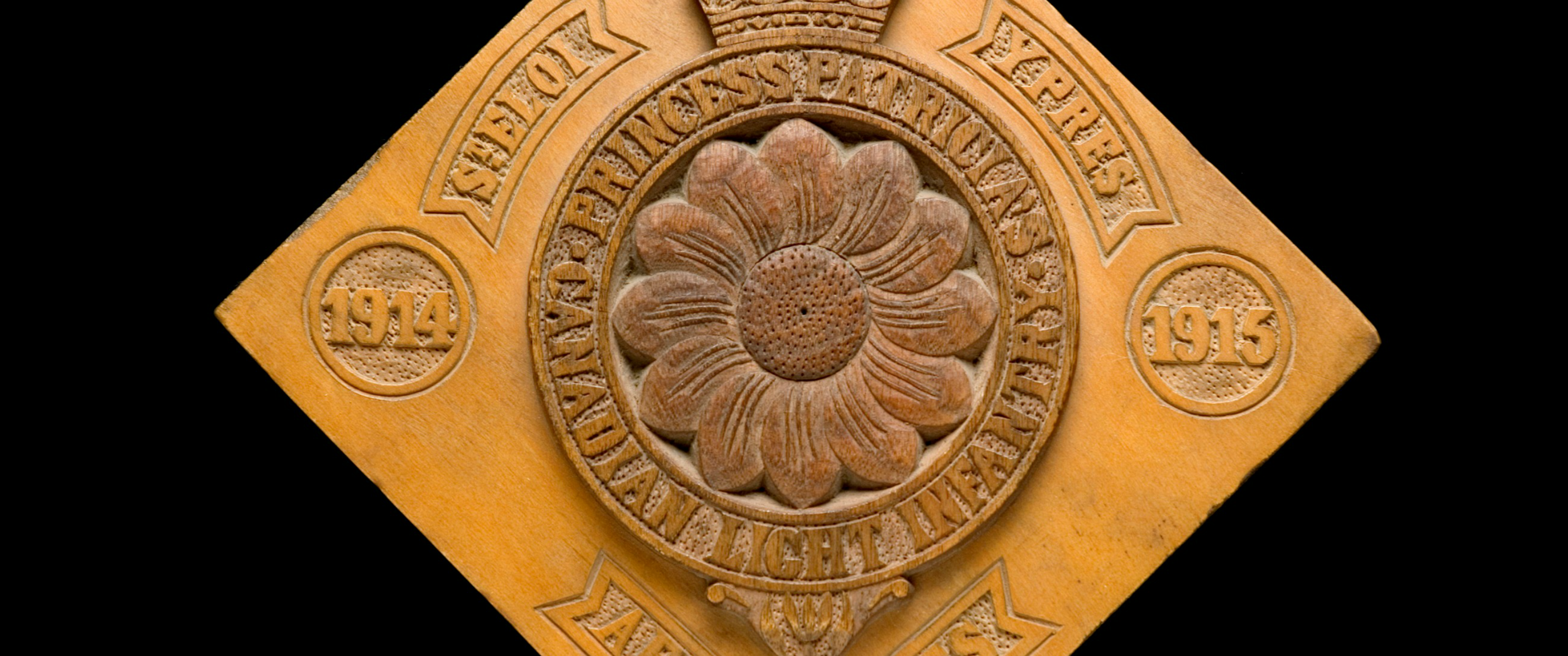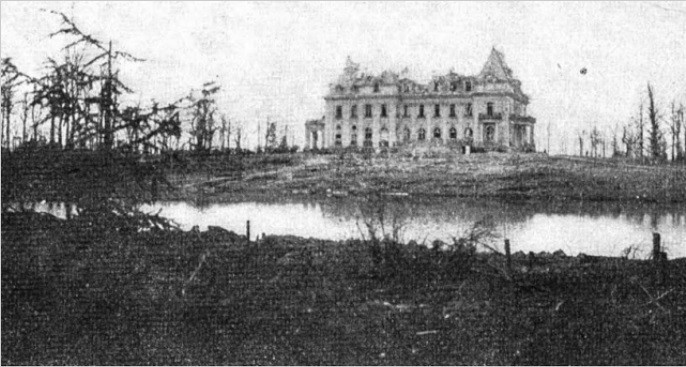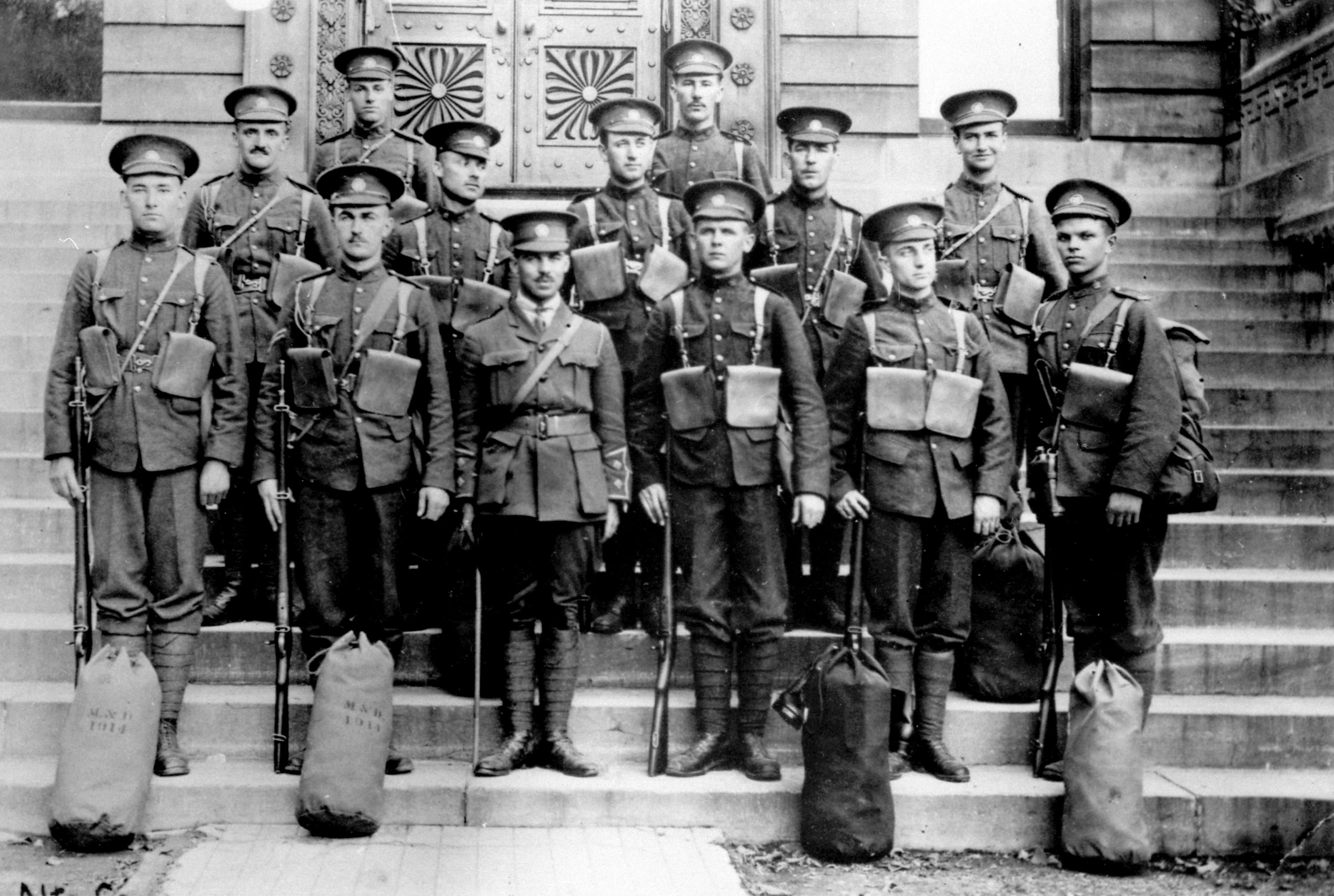 "Princess Patricia's Canadian Light Infantry World War I plaque", 1914-1915
"Princess Patricia's Canadian Light Infantry World War I plaque", 1914-1915carved wood
University of Alberta Art Collection (2007.36.1)
University of Alberta Museums
In North-West Belgium, a soldier sifts through the rubble of the decimated White Chateau. He finds a salvageable bit of wood, slips it into his pack, and sets back for his dugout. Wading through sodden trenches, he praises again the knitted socks on his feet - a gift, recently arrived, from the university he left behind when he crossed the Atlantic. News from home rests folded in his pocket. He sits in the mud, and begins to carefully etch the surface of the salvaged wood with a pen knife.
 The White Chateau, Hollebeke (near Ypres), Belgium. (Image courtesy of Ypres 1914: Messines: Early Battles 1914)
The White Chateau, Hollebeke (near Ypres), Belgium. (Image courtesy of Ypres 1914: Messines: Early Battles 1914)
Back in Edmonton, a small group of faculty and students gather in Room 151 of the newly-opened Arts Building. It is October, 1915, and the absence of so many friends and colleagues weighs heavily on campus. The University of Alberta is not yet six years old at the outbreak of war. Nearly three quarters of its 433 students have left their studies to fight in Europe.
Those who remain on campus pull together to support their absent classmates. But how? They can knit socks and warm clothing, they decide; send candy, baked goods and cigarettes; and stay in contact through correspondence and newsletters. Before they leave for the evening, the University Soldiers Comfort Club has taken shape. The club's steadfast support for U of A soldiers serving throughout Europe will persevere through the long years of the war.
April 8, 1916: the Comfort Club's first mimeographed newsletter grieves the death of Arthur Deitz. Deitz had been killed on his first day on the line. Through the following years, these somber announcements punctuate the publication. Veering between news from the fronts, occasional levity and humor, excerpts from soldiers' letters and solemn pronouncements of the fallen, the newsletter's issues capture the horror and human experience of the Great War. "I am writing this in my dugout as I am on duty at my phone and buzzer at present," one letter excerpt reads, "with the cannon roaring around and the bullets flying too. This is war."
Canada became a nation on the battlefields of the First World War - and hundreds of the U of A's first students and…medium.comThe soldiers
Canada became a nation on the battlefields of the First World War - and hundreds of the U of A's first students and…medium.com
Another letter - this one from Francis Galbraith - recounts a gruesome battle at Sanctuary Wood, in which two of Galbraith's classmates were killed. "It's useless to attempt to describe it as there is nothing to compare it to…" he writes. "It will be a long time before we forget our experiences of the last few days."
 Montréal, 1915. Francis Galbraith appears front left.
Montréal, 1915. Francis Galbraith appears front left.
Despite the bleak updates, the Comfort Club persisted with its news service, sending regular newsletters (along with clothing and gifts) to U of A soldiers abroad, as well as distributing letters and news at home. They held onto a sense of community at a time when communication was slow and intermittent, and students and staff were scattered across continents. "Those of us who are in the Imperial Army seldom come into contact with any of the Varsity boys," a student serving in the British army wrote home. "The News Letter is the only medium of contact and thus we appreciate it all the more."
In the trenches of Belgium, the salvaged chateau wood is skillfully carved into a plaque. It bears the crest of Princess Patricia's Canadian Light Infantry (PPCLI), and the names of battles survived: St. Eloi, Ypres, Armentier. Onto its back, twenty signatures are inscribed - the names of U of A soldiers in the PPCLI, thanking the Comfort Club for their latest news and gifts. "Galbraith" appears among the names. Of the 20 men who sign, he is one of three to make it home.
 The back of the PPCLI Plaque bears the signatures of 20 U of A soldiers. Only 3 would make it home.
The back of the PPCLI Plaque bears the signatures of 20 U of A soldiers. Only 3 would make it home.
The plaque - sent from the front as a token of thanks to the University Soldiers Comforts Club - still sits in Arts and Convocation Hall, where it commemorates the 82 staff and students who lost their lives in the First World War.
Lest we forget.